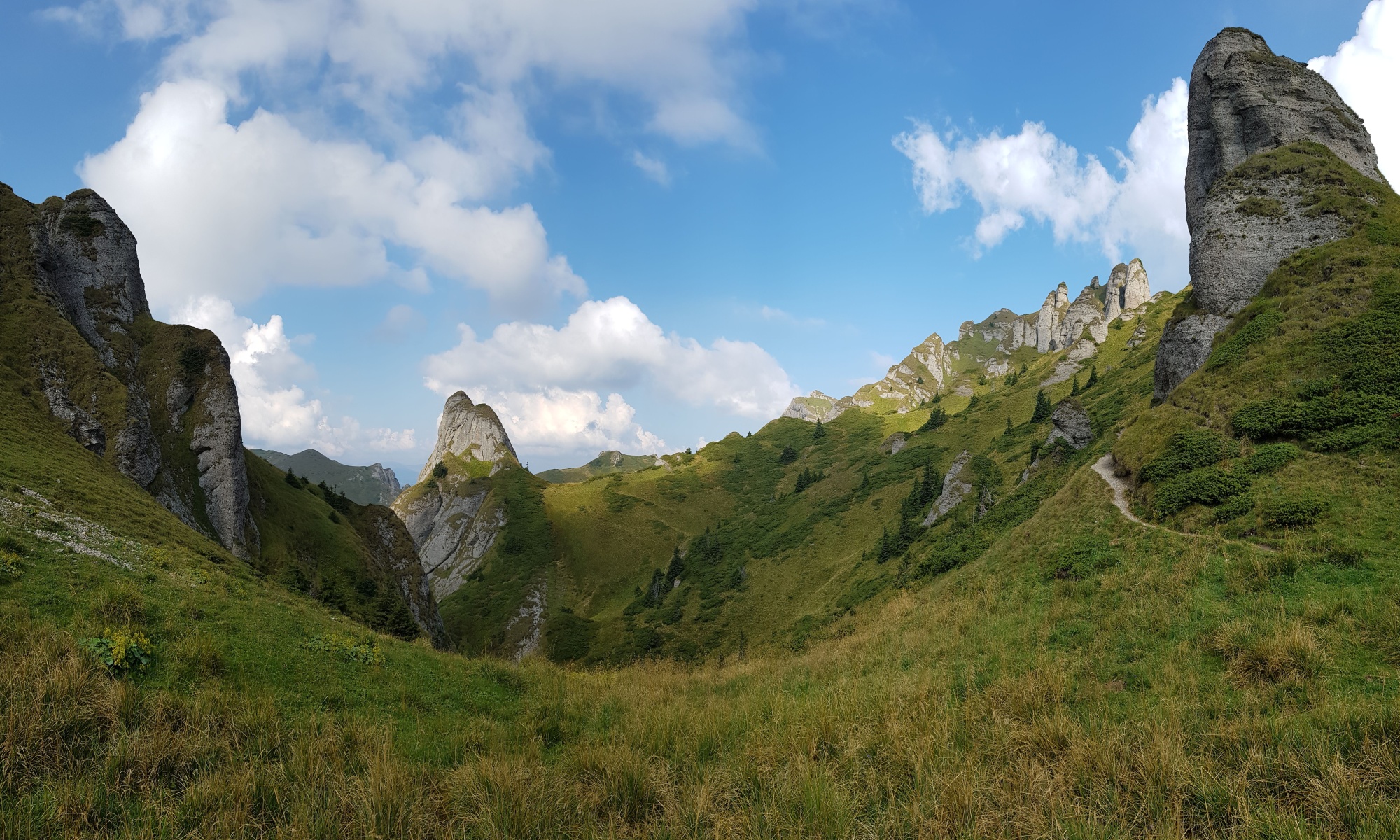Specifics | Timing | Supplies | Risks | Orientation | My gear | Philosophy
What is different in the Carpathians
Contrary to many other long-distance hikes, in the Carpathians you find few ranges where you can meet scores of tourists – Tatry, Východní Beskydy, Munții Rodnei, Piatra Craiului, Făgăraş, Retezat – these account for about 16% of the thru-hike. So mostly you walk trails, ridges and forest roads where you are the only hiker in a day, a week or two. At some places there is no trail visible and you need to make a trail on your own.
To make the point, in Slovakia I met only 1 multi-day hiker on 200 km between Slovenský raj and the Dukla pass. Apart from Polonina Borzhava I met only 2 hikers in Ukraine but could see 3 tents at Polonina Svidovec. The number of hikers I met between Rodnei and Piatra Craiului was 2 (two!) on the distance of 550 km. So apart of the few popular ranges I met on average one hiker per 137 km.
This does not mean there are no humans in the mountains. A settlement is rarely more distant than a day walk and the mountains are inhabited by shepherds along with their herds and dogs in summer. Hikers are visitors in their land and it is better to avoid Romanian Carpathians unless you want to accept this fact. Hiking trails follow the paths shepherds have been using for centuries and that is why the sheep-dogs attacks are so frequent there. At many places a walking hiker is treated as a being that appeared out of thin air and the locals simply do not know, how to react in this situation. On the other hand, you can be sure they help you, when in real need.
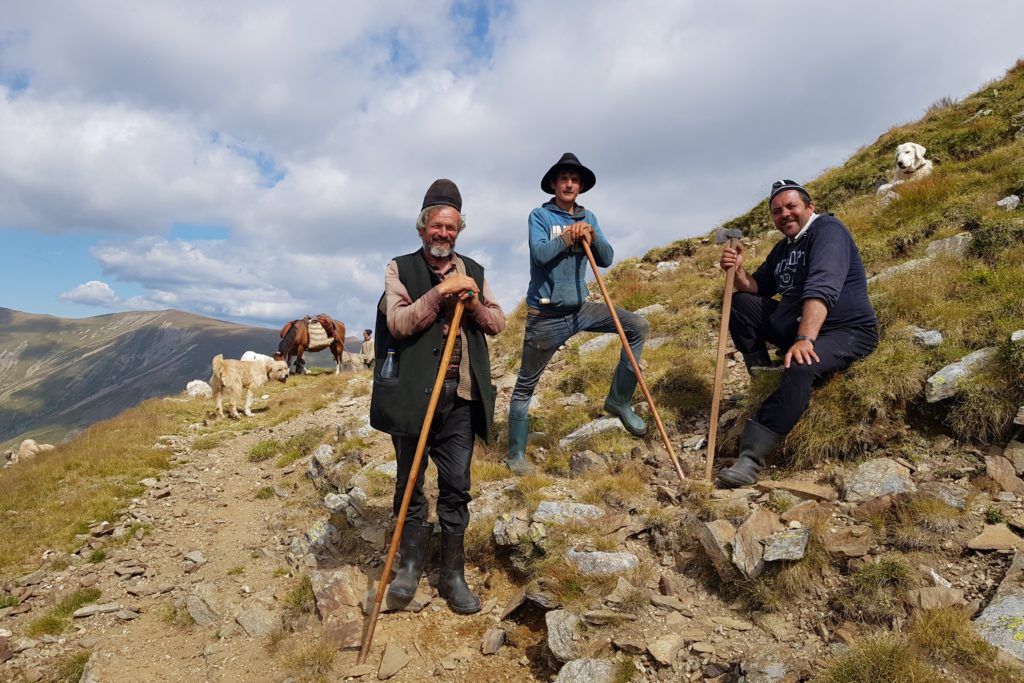
The Carpathians run through several nations so it gives a hiker the pleasure of using many languages. Do not expect locals to speak any international language. Hungarian is spoken on western slopes of the Eastern part of the Carpathians. Young Romanians, Czechs, Slovaks and Poles are usually fluent in English. Many Ukrainian men understand Czech, Slovakian, Polish and Lithuanian from their working abroad experience, all Ukrainians are fluent in Russian.
Apart from Slovakian E8 it is very unlikely you meet any long-distance hikers. In 2019 almost met with Michał Kulanek who was walking across Carpathians in the same direction and we connected through Facebook.
The other side of the coin of this solitude is freedom. Freedom to walk and camp and collect forest fruits, freedom one hardly experiences in other European mountain ranges today. This of course does not apply to strict national parks (Tatras, Poloniny, Rodnei, Ciucaș, Bucegi, Piatra Craiului, Retezat), where hikers must stick to the designated paths and camping areas.
…
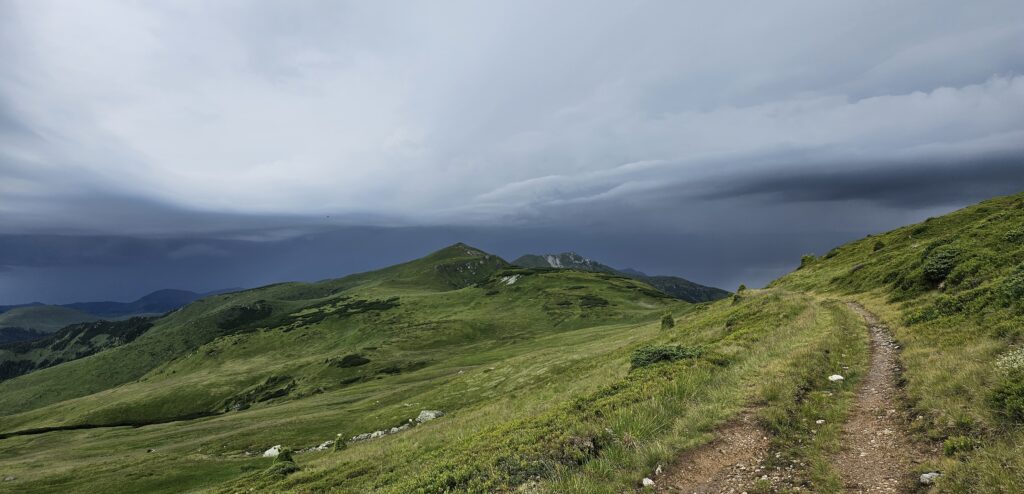
Timing
If you want to hike all the highest mountain ranges in the Carpathians without special equipment for snow conditions both timing and direction matter. The Romanian part of the thru-hike is definitely more demanding than the Slovakian and/or Polish. That is why many hikers rather start from the Danube in Romania. In this case you need to take into account that in early June there are still snow patches in Godeanu and Retezat mountains and you might not be able to cross Făgăraş till the end of June. Safe date to start from this direction is mid-June. Another advantage of this direction is almost no mosquitoes as you approach lower altitudes in late summer.
In case of the start from the Danube in Slovakia (or like in my case the westernmost Pálava range) the timing depends on the route: 1) if walking north from Vysoké Tatry through Poland, the start is possible as early as April. 2) Nízké Tatry are passable from early June so mid-May start is OK taking this route. 3) If you want to cross Vysoké Tatry the situation is similar to Făgăraş – mid June can be considered safe start, however, the considerable difference is that camping is not allowed in Vysoké Tatry so you are obliged to stick to mountain chalets.
Expect below zero temperatures overnight at both end of the arc in the second half of September. The first snow definitely comes before the beginning of October to the highest peaks but it should enable passing. The mountains in Romania become deserted once the shepherds descend with their herds to the valleys in September (in one dry year I experienced deserted shepherd’s houses at the end of August). The same applies to early June before the fresh grass grows. The advantage is you can use shepherds’ houses for overnights then.
Your experience from the thru-hike will be highly impacted by weather. The very same ranges can be experienced as muddy or dry in the same week in different years. There is no general advice regarding the weather, however, expect not more than half of your hiking days without a thunderstorm or a shower.
…
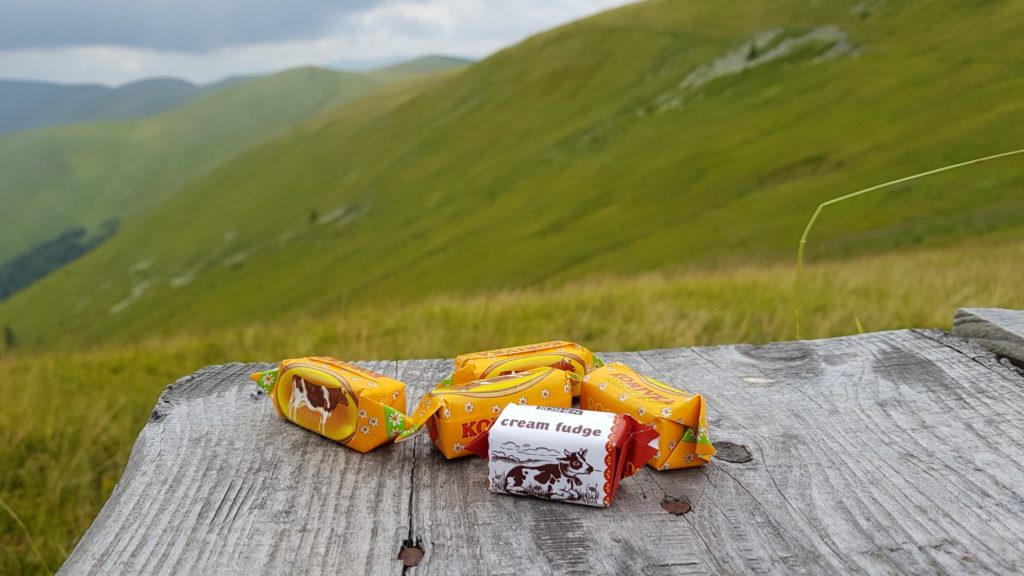
Supplies
Supply of food for hiking in village shops is wider in Slovakia, Poland and the Czech Republic, especially dry instant food. Expect limited offer in Romania and poor in Ukraine. However, the supply of basic food is easily accessible in all the countries. I mean oil, sugar, rice, buckwheat, cous-cous, chocolate, raisins, instant noodle soups. Sunflower halva, which has superb price/weight/energy ratio, is available in Ukraine and Romania. Cottage cheese (but not milk) can be obtained from shepherds. Special food like full-nutrition powder, isotonic drinks, frost-dried fruits is not available along the trail at all.
Sport/outdoor shops are located in large cities far from the trail. Expect them in Trenčín, Poprad, Sighetul Marmației and Petroşani if following in my footsteps. Some hikers detour to Braşov or Bistrița to get necessary stuff. I tailored my gear to stay in the mountains for the whole hike.
While in the Czech Republic and Slovakia, alcohol fuel can be obtained in drugstores, in Ukraine and Romania in pharmacies. Ukrainian alcohol was the finest quality, cheap Romanian 70% blue liquid was always leaving some unburned leftovers.
I tested poste-restante delivery to post offices in Slovakia and Romania and it worked fine (apart from one case). During 2019 thru-hike in Romania I received the first parcel in Borsec, took some stuff and split it to two – one went to Bușteni, the other to Petroșani. You need to provide an address in Romania while sending the parcel to which it is delivered if not picked-up. While walking the northern trail I tried Paczkomat delivery in Poland (self-operated box to box delivery), but it appeared to be too fast and I needed to pay penalty for my package waiting in the box.
Only once I took a 10 minutes lift from a mountain pass to a nearby village for supplies. I needed to compensate for the joy of being out-of-touch with civlization by heavier backpack (up to 6 kg of food).
Water is mostly available across the Carpathians. Eastern Beskydy range and limestone mountains are drier. There is no necessity of filtering water unless dirty or taken from stagnant pools. You can download the water sources coordinates here and navigate to the description of my daily water management.
..
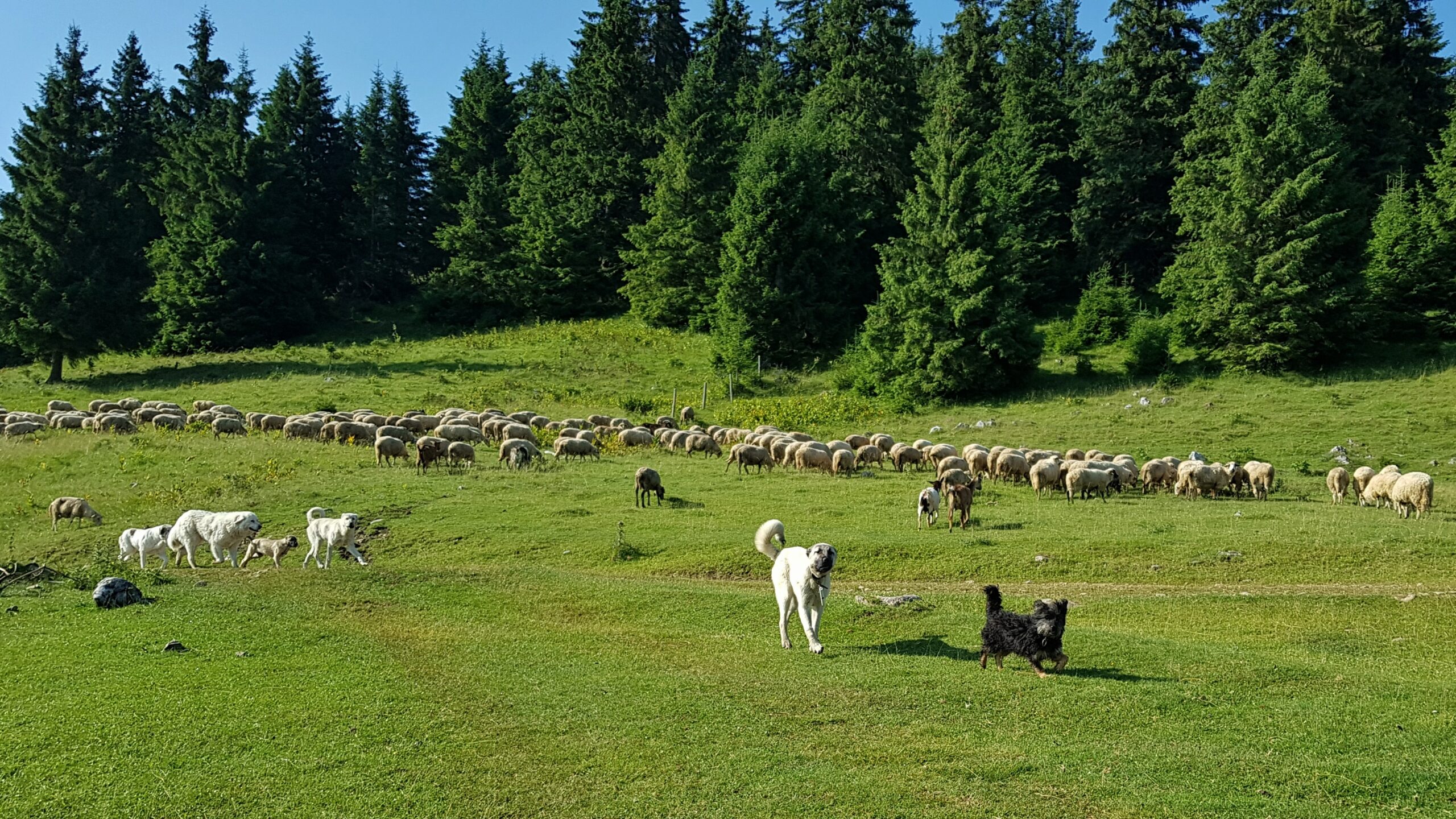
Risks
Sheep Dog Attacks | Bears | Other Wildlife | Ticks | Thunderstorms
Bears, aggressive sheep dogs, ticks and thunderstorms are the realities you cannot avoid walking across the Carpathians.
Out of those, SHEEP DOG ATTACKS are the most exhausting for a lonely hiker. Expect them in Romania, everywhere out of the few areas with tourist presence (like Rodnei, Bucegi, Făgăraş). I went through as many as 10 attacks a day. Dogs understand well, when in superiority and are naturally set up for attacking lonesome individuals. Being in a group is the best protection from severe attacks.
The worst attacks happen in early morning and in the evening, when shepherds are busy with their sheep, meanwhile both dogs accompanying herds and those staying at the base are united in one pack and got nothing to do. Each attack is individual so there is no universal advice, however, I would suggest the following:
1) track and watch – it is always better to be aware of the dogs before they sniff you. Try to avoid the attack if possible.
2) always keep 3-4 stones in your pocket. If expecting an attack, hold both trekking poles in one hand (dogs are regularly beaten by shepherds and seeing a long stick scares them). Keep pepper spray in your pocket and increase the ammunition of stones.
3) seek for the shepherd’s help first, only he (she) can calm down the dogs.
4) ignore the dogs to the point when the attack is imminent and they break your perimeter (10 meters), do not bother with 1 or 2 dogs, they either do not attack or you can easily repel them. If dogs are only scaring you off by barking (most of the cases), do not pay attention to them and do not follow the next point, which definitely opens up aggression.
5) if the pack of more than 3 dogs is aggressively approaching = snarling, do not show fear and attack the pack leader first, the bigger the stone is, the better. If there are no stones in the area, make movements as if you were picking them up from the ground and throwing in between throwing your reserve real stones. If you got a stun gun, do not bother with stones and discharge it towards the pack leader (the sound scares the dogs).
6) try to keep dogs in the distance and far from each other (split the attackers – if 2-3 hesitating dogs leave the pack after being hit, the others stop attacking).
7) constantly search for the shepherd’s help.
8) if they manage to get very close and try to bite, face them moving towards a shepherd or your direction (do not turn your back or run away!) and start active defense depending on your weapons:
8.a) Stones: continue throwing stones without mercy. Do not rely on trekking poles – they are too short, block your palms and make dogs more furious.
8.b) Stun gun: proved to me to be a great defense tool. Dogs are shocked by the sound of the discharge and stop the attack for a while. If repeated too much with no direct effect, they start attacking again, but you earn the valuable time. And of course you can use it in case of close contact.
8.c) Firecrackers: a Romanian ranger told me this works great, but I have no personal experience with firecrackers.
8.d) Nothing: shouting loudly as if giving orders sometimes helps to stop the attack.
8.e) Other tools: Whip should work very well since shepherds use it. I tried slingshot for few Romanian treks but it did not work as the dogs do not know it. I keep pepper spray ready in case of a bite but I have never used it against dogs.
9) respect that the dogs are just doing their job and be nice to a shepherd. There is an ongoing conflict between shepherds, hunters and tourists in Romania even at legal level. Showing your sympathy to a representative of this centuries old craft is appreciated. Give a smile, shake a hand with a shepherd, exchange few words and apologize. Make mountain brotherhood, do not feed animosity.
I got five BEAR ENCOUNTERS during my Carpathian solo thru-hike. It is hard to say how many times a bear got out of my way without me noticing, but my guess is at least dozen times. On the other hand, I had not encountered a single bear on dozens of my previous Carpathian hikes. I can see the following reasons for that: a) bears usually avoid the popular higher ridges with tourist footpaths, b) while walking in a pair or group we make more noise and watch the surroundings less, c) bear population was considerably smaller in the past.
In the Carpathians there are ranges with high bear density (Veľká Fatra, Călimani, Vrancea) and then there are spots and daytimes where meeting a bear is imminent. I shall not write about the bears used to humans that are begging along roads in Romania or regularly attack tourists at the footpath between Bușteni and Cabana Caraiman. They are the most unpredictable and the only advice is to avoid them.
Unless curious (happened to me once), the brown bears you encounter in the wild have the paramount desire of not meeting a human. And we should help them with it following few simple steps:
– Do not walk at dusk or at night (this is no. 1 advice).
– Keep pepper spray easily accessible (I have it in the pocket of my hipbelt and move it to the pocket of my trousers, when the signs of bear presence occur).
– When in the terrain with visibility below 150 meters, make noise (I use jingles), this study shows that a third of bear attacks in Europe happen because the animal is caught by surprise.
– Keep your food in a sealed drysack and near to you overnight (some might dispute this, but it has worked for me as well as other hikers). Avoid any attractive smells around your campsite (e.g. food leftovers, grilled meat). If cold soaking in a pot – seal it and keep it either close to you or away from your campsite.
– Mark your territory, pee on a path a bear may use 30–50 meters from your camping spot.
– When you can see the signs of bear presence, be vigilant and make extra noise (e.g. combine jingles with singing). The signs of bear presence are: bear tracks, shattered rotting trees, upturned stones (bears search for insects below stones and in the wood), rummaged anthills and wasps’ nests, scratched tree-trunks and of course bear droppings. In summer bear droppings are typical by the purple color and it is quite easy to assess, how fresh they are.
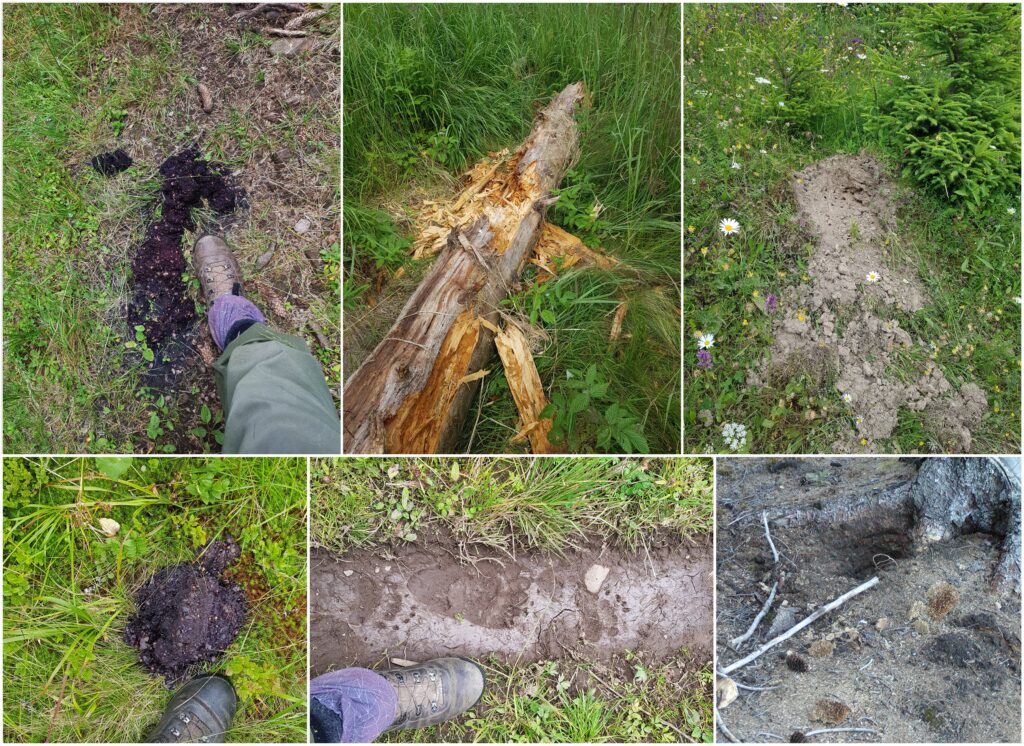
In case you meet a bear:
– assess the situation, if the bear is far from your trail and your movement cannot be intercepted as dangerous, follow your way, without paying attention to the animal.
– if the bear is close to your trail and has not noticed you, slowly and silently retreat and try to walk around in considerable distance.
– if the bear has noticed you, identify as a human by speaking softly while retreating. Once I made a nice monologue lasting several minutes with a bear staring at my campsite from 60 meters distance. However, try to avoid looking into its eyes or casting flashlight during the conversation.
– if you meet a playful cub, retreat immediately. No time for pics or selfies with it, frightened mum will follow. According to this study, 50% of bear attacks in Europe is associated with female bears with cubs.
– if the bear charges, it could well be a false charge and the bear stops near you. I have never been in this situation, however there are two options depending on your equipment:
1) You have your pepper spray ready: discharge it from about 3 meters towards the bear’s face.
2) You do not have a pepper spray: the advice is to stand still or slowly lay on the ground with your face down. When lying on the ground, put your hands around your neck to protect your head and face. Be passive and remain as quiet as possible until the attack ends.
I can remember an account of a Slovakian surgeon who was treating many forest workers injured by bears during his career. He was surprised that such a mighty animal makes relatively mild wounds to humans.
In 2023 a bear attacked a runner in Slovakia (surprise encounter early in the morning), the man slipped while trying to escape and the bear attacked him lying on his back. Though the the runner was totally defenseless, he survived with some bites and scratches only. It is obvious European bears do not treat humans as food for they are able to tear a horse to pieces. We should also mention, there has been on average one fatal bear encounter a year in the Carpathians over the last 20 years.
What not to do: do not immediately lie down on the ground – this could make the bear curious, do not scream, do not make fast movements, do not try to scare the bear away – might work several times but could as well turn into disaster. Do not run away. I could see a running bear near the Oituz pass and believe me they can run really fast. Do not leave food leftovers near your campsite.
OTHER WILDLIFE
I encountered a wolf only twice, but could hear howling and tracked it quite frequently in different parts of the Carpathians. They pose no danger to humans. My friend even encountered a wolf-pack in winter while camping on a remote ridge and they passed by the tent with two frightened humans inside.
Seeing a lynx is a lifetime experience. I could see it only once from distance in Eastern Poland. They pose absolutely no danger.
Some people (UK hikers in particular) are afraid of wild boars. There are cases of their attacks in Central Europe, but I got several close encounters without any trouble. One night we even got to the middle of a wild boar herd crossing the footpath. I could feel them touching my legs but they were just going their way. Once we found a den with three piglets and could see their mother running away. However, in this case it is advised to leave the site immediately. Wild boars are more frequent in the western Carpathian ranges, less in Romania and Ukraine.
TICKS are very common all across Carpathians in altitudes below 900 meters. They transmit two diseases: Tick-borne encephalitis (TBE) and Lyme borreliosis (LB). Vaccination is the best protection against TBE virus. From the time my friend ended up confined to bed totally paralyzed, I suggest everyone to apply the vaccine.
Lyme borreliosis is a bacterial disease, while vaccination is possible in North America, European vaccine is still in the testing process. However, it could be easily cured if discovered in early stage. First step in prevention of the disease is taking tick out of your body as soon as possible and disinfecting the spot immediately. Normally the place is itching for few days and small red circle (an inch or two wide) appears around the spot. However, if the red spot grows over time into several inches or even palm-size, the LB bacteria got into your body. In this case you need to apply antibiotics (like amoxycilin). Keep in mind that many times the tick leaves your body unnoticed. To comfort folks from non-tick areas: I personally caught well over 1000 ticks in my life and am still alive, no TBE and (hopefully) no LB.
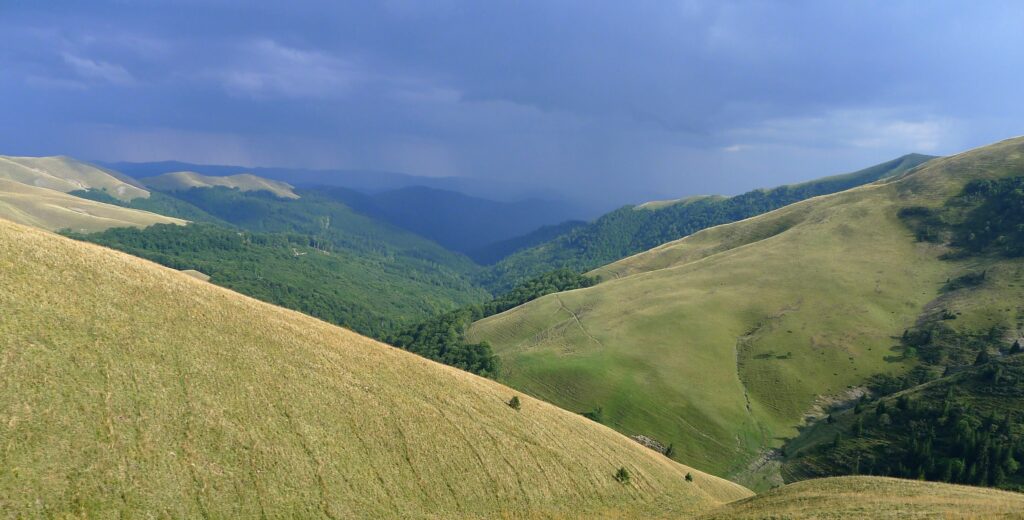
There are basically two types of THUNDERSTORMS in the Carpathians:
1) thunderstorms originating from local evaporation. These thunderstorms occur more often later in the day. They are bound to cumulonimbus clouds and thus localized to area of few square kilometers. One year we got this type of weather for 5 days in Grohotiș and Ciucaș mountains – every afternoon there was a thunderstorm. As these thunderstorms are well visible from distance in the high mountains, their movement can be predicted and a hiker got time to get ready. When caught in this type of thunderstorm high up in the mountains, I sit down isolated from the ground by my backpack with only one leg touching the ground my poncho isolating both me and the backpack enjoying the raindrops bites. This type of thunderstorm moves fast and it leaves a spot within 30 minutes.
2) thunderstorms during cold front crossings. These thunderstorms happen over large areas, can come any time of a day, last longer (especially when the head of the front stops at the mountain range) and are usually followed by hours of rain. Lightnings during these thunderstorms can turn night into a day with constant light and thunder drumming. As weather forecast is easily available these days, I suggest hikers to watch it and find a shelter out of the high ranges for the hours of a cold-front crossing.
..
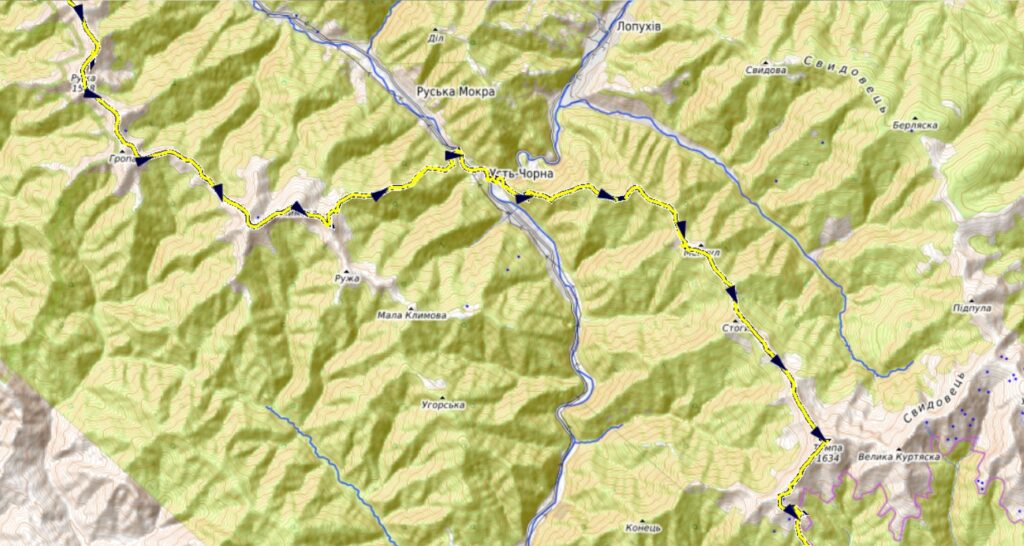
Orientation
My first trips to the Carpathians were based on 1:100 000 Czechoslovakian maps of Slovakia and sketches published in 1986 Guide to Romanian mountains. For the past 15 years I have been relying on digital maps only. For the thru-hike I backed up smartphone with the trail in smartwatch.
THE APPS I have used (Android):
Mapy.cz – free of charge with very good free offline maps, connected with an online planning tool. Though this is #1 choice for most of the Carpathian hikers, I am personally not fond of this app because of very poor customization and battery drainage issues I got with it. I use it as a second source of info if needed now and then double checking the app is turned off afterwards.
PathAway – has been my app of choice for almost two decades. High customization, trekking function, on-the-go download of maps (Open Topo) for offline use. Unfortunately, the app still retains its Windows Mobile era UI and its slow responsiveness drives me crazy. The tool for sharing position has not worked for me.
LocusPro – my app of choice in the past few years. The default offline maps are a bit less informative than mapy.cz, but I can always switch to other map sources within the app both free and paid. Well arranged UI, smooth operation and bunch of plug-ins enhancing the program.
Soviet Military Maps – though the map sources are 50 years old, it gives nice overview and alternative source of information.
Munţii Noştri – Romanian-made app aspiring to cover this part of the Carpathians
AvenzaMaps – the largest collection of printed maps turned digital (my experience is the transfer to digital version is not always precise).
PRINTED MAPS
Today the whole region of the Carpathians is covered by tourist maps. While in the Czech Republic, Slovakia and Poland maps can be obtained in shops close to the mountains as well as in mountains hotels, in Ukraine and Romania it is a bit more difficult once you are out of the large cities. Some of the sources for buying printed maps:
Czech Tourist Club edition – high quality 1:50000 maps
Tourist maps of Slovakia – different publishers and scales
Maps of Poland – and actually all the Carpathians
Romanian edition of tourist maps
Archive of scanned maps of Romanian mountains
Older archive of Romanian maps – seems not updated
PLANNING
I use Mapy.cz for rough planning, export the gpx and then fine-tune the trail in the Quo Vadis software. I also use this software to process the data collected on the trail.
..
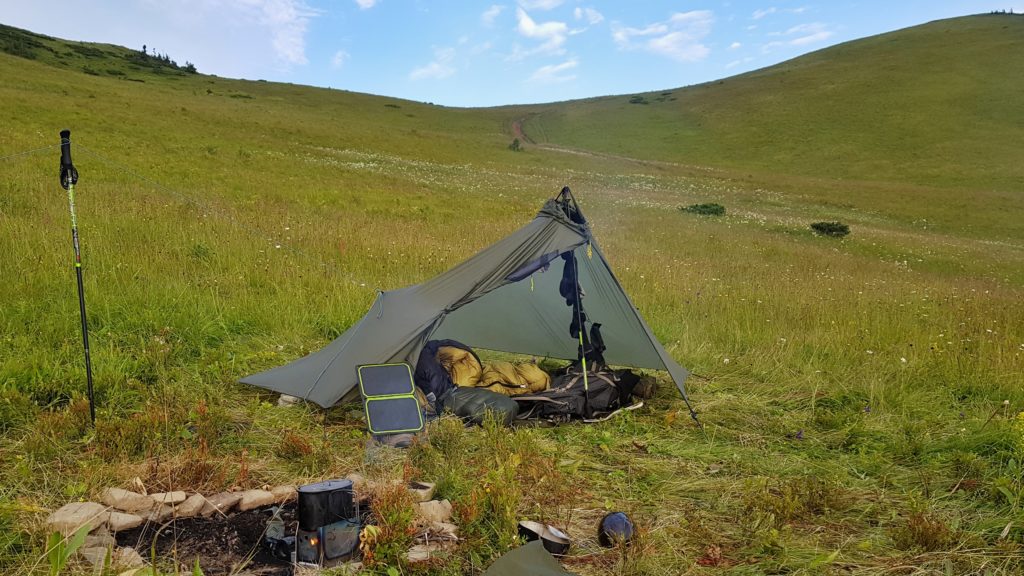
My gear
Unlike in the Alps, outdoor shops are far away from the mountains and you can easily tear your gear while elbowing through bushes or new growth at places where once might had been a path. The “land management” has been changing significantly in Romania and Ukraine since 1990s. After clearcuts and thunderstorms paths are blocked by logs and overgrown by high grass and bushes. Often old paths diminish in the new growth as they are not used so frequently today. This means lot of improvisation and preparedness.
My backpack is not the lightest one for I know I may not meet a person for days and I want to be prepared for all sorts of troubles. Its base-weight is almost 7 kilos. Along with consumables (food, fuel) and water I usually carry below 14 kilos after the re-supply. That is enough for 10 days long trek in the Carpathians. Water management throughout the day plays also an important role.
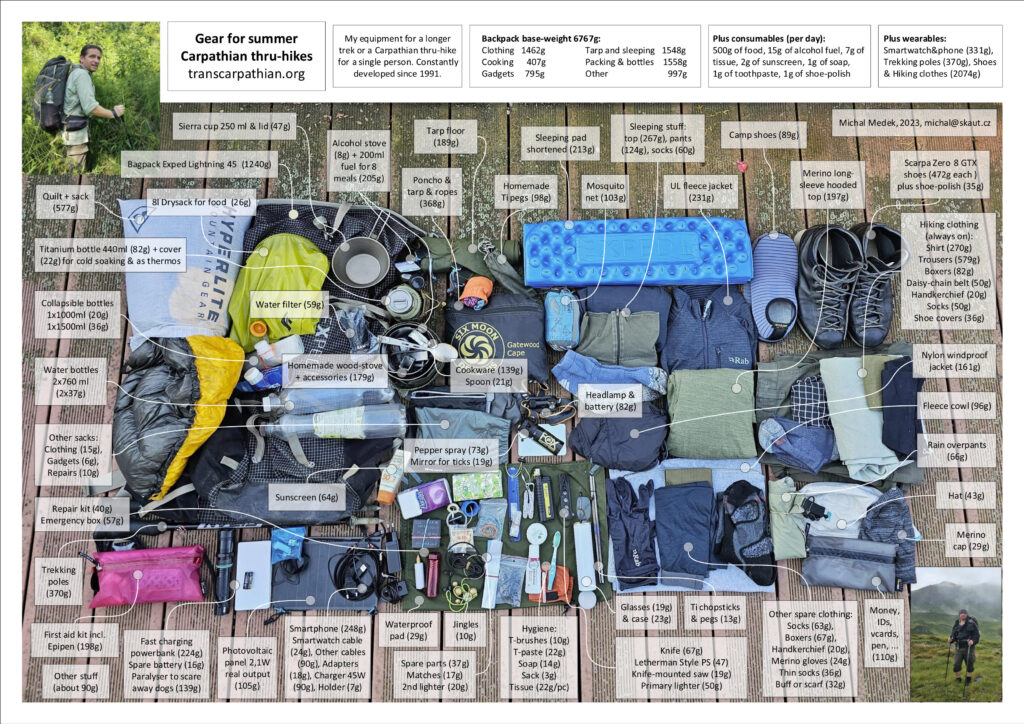
The pack for the 2019 thru-hike was about 8600g. I must say I did not use about 450 grams of repair kits, first aid stuff and pepper sprays. I also carried a keyboard (177g), a scout scarf, and my first-aid kit included two packages of Epipen (55g each). The cooking setup was too powerful for a single person and the sleeping bag too warm.
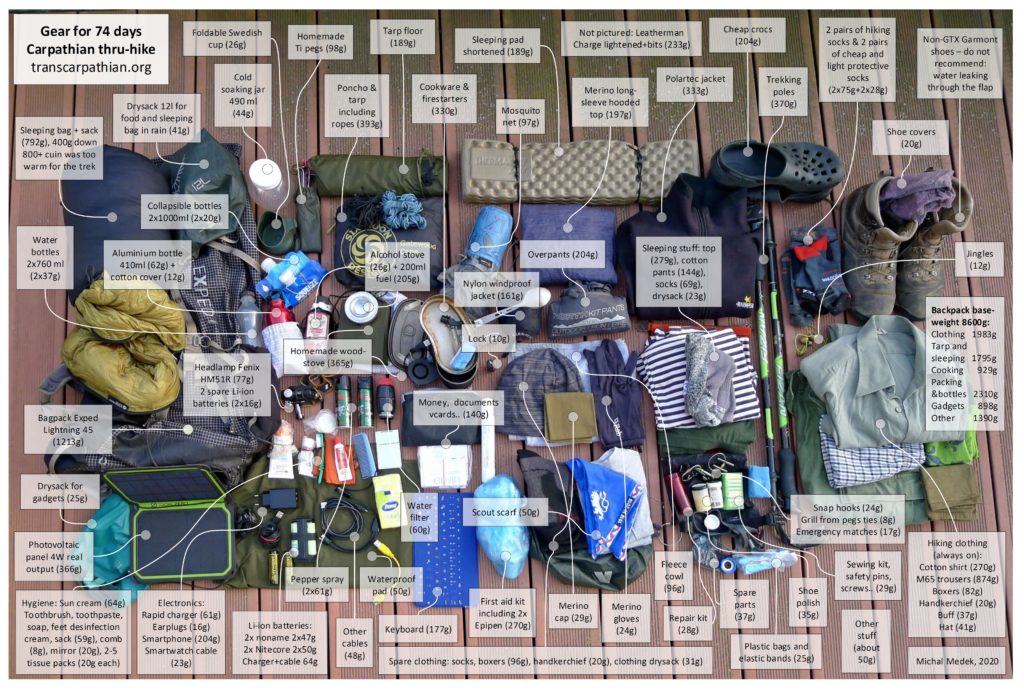
In general my advice regarding the gear for Carpathian thru-hike is:
1) Do not apply experiences from popular (US) trails to the Carpathians and mind that the guys out there making videos about ultralight backpacking earn their money from your clicks.
2) Fast charging is a must. Unless staying overnight in civilization, there is no way, how to charge a powerbank with a 6 hours charging time. In 2019 I got the opportunity of overnight charging only 5 times during 74 days, but other hikers have different strategy and stick more to civilization.
3) Long pants are necessity as you often need to make your own path.
4) Mind that there will be some rain on 40% of your hiking days => good raingear and waterproofing the backpack content saves you lot of troubles. I keep a waterproof pad in my pocket to put my backpack on it or sit down on wet surfaces.
5) Fan-powered woodstove is my choice for the Carpathians. It makes the magic of fire, enables fast cooking (including food that needs long boiling time) and provides warm water for warming-up, hygiene and laundry. I do not need to bother about fuel and unlike with campfire I adhere to the leave-no-trace principles. In sensitive areas I use an efficient liquid alcohol stove (20g of fuel makes 0,5l of water boil for 7 minutes).
6) Despite outdoor shops’ and commercial hikers’ claims, hiking is not about gear.
..
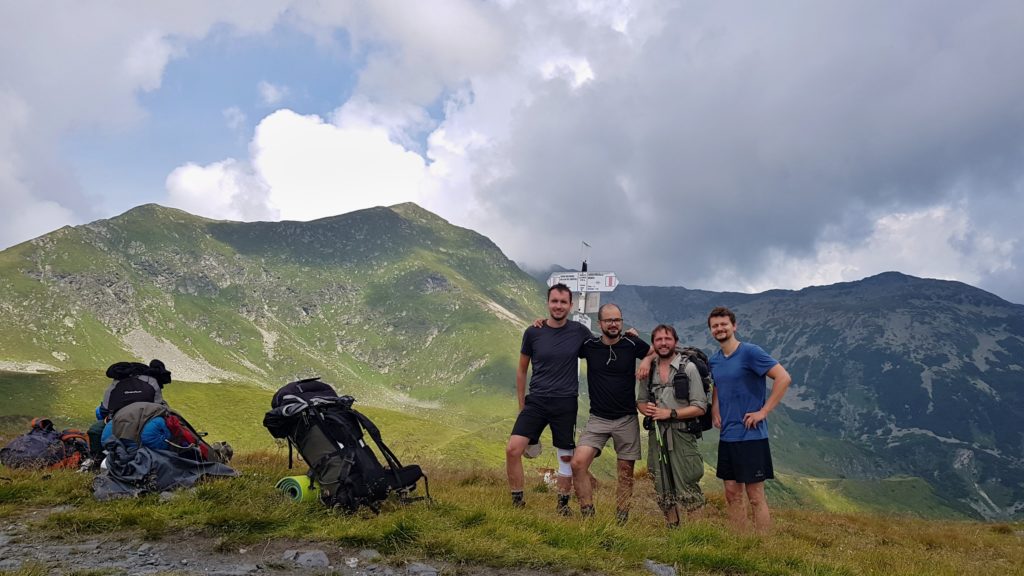
Philosophy
However much I do not consider my journeys a sport performance but a pilgrimage, I must admit that the fact I wanted to walk all the Carpathians in the given time turned the 2019 hike into kind of a contest. Unlike during my previous journeys I felt I lost large part of the feeling of freedom once I was comparing my advance with the schedule I prepared before.
But in other aspects I followed the philosophy I had embraced 25 years ago: local sources + less comfort = less weight = nicer experiences. The philosophy I learned in the book Carpathian Games by Miloslav Nevrlý.

